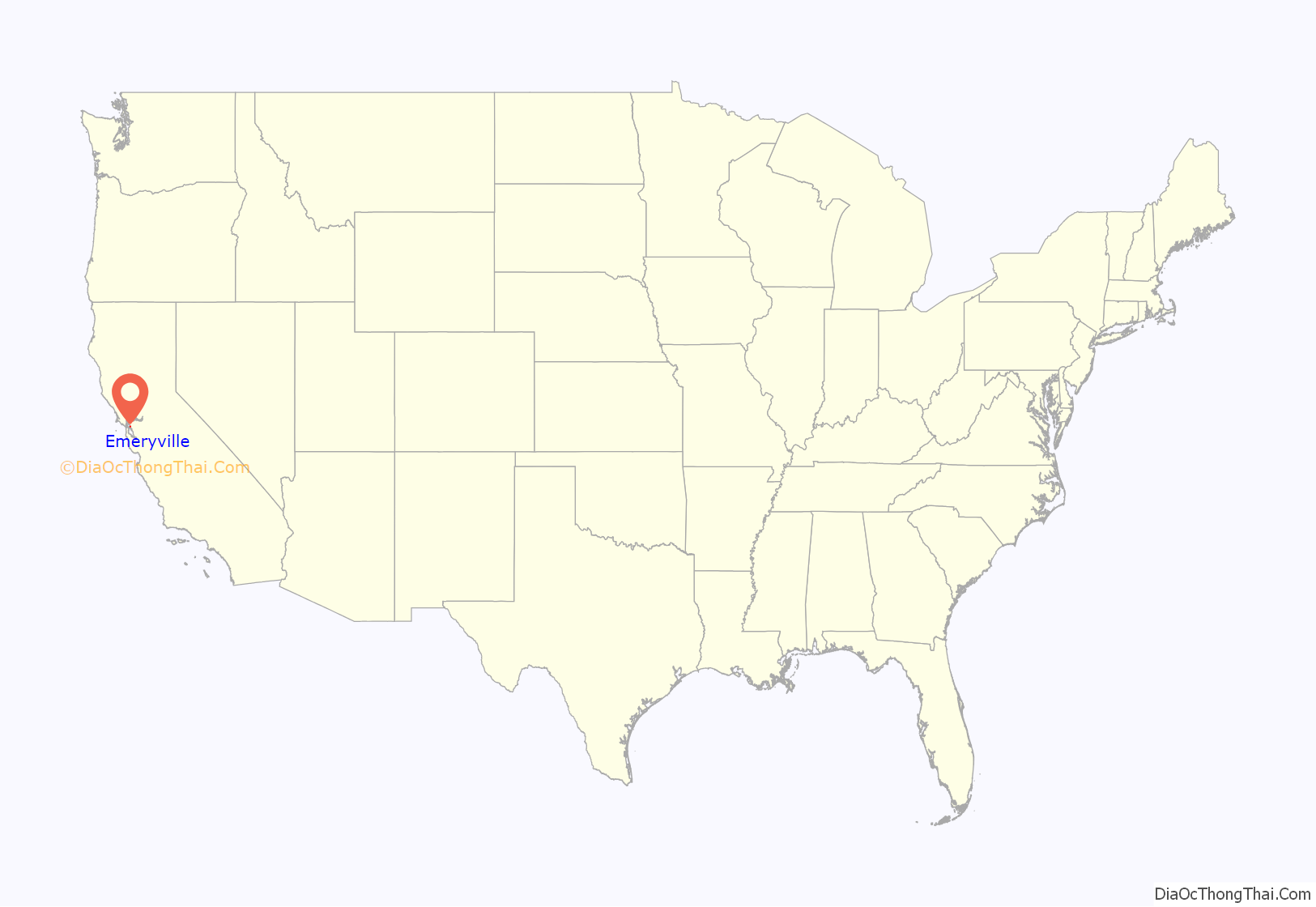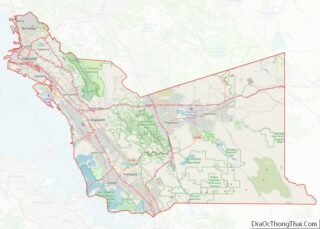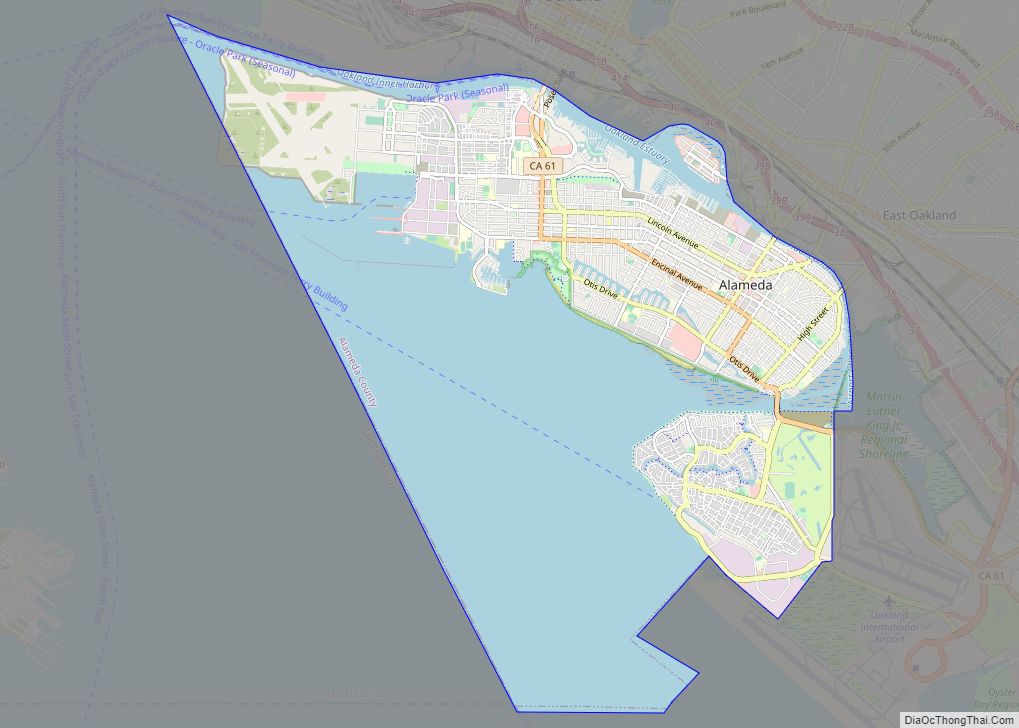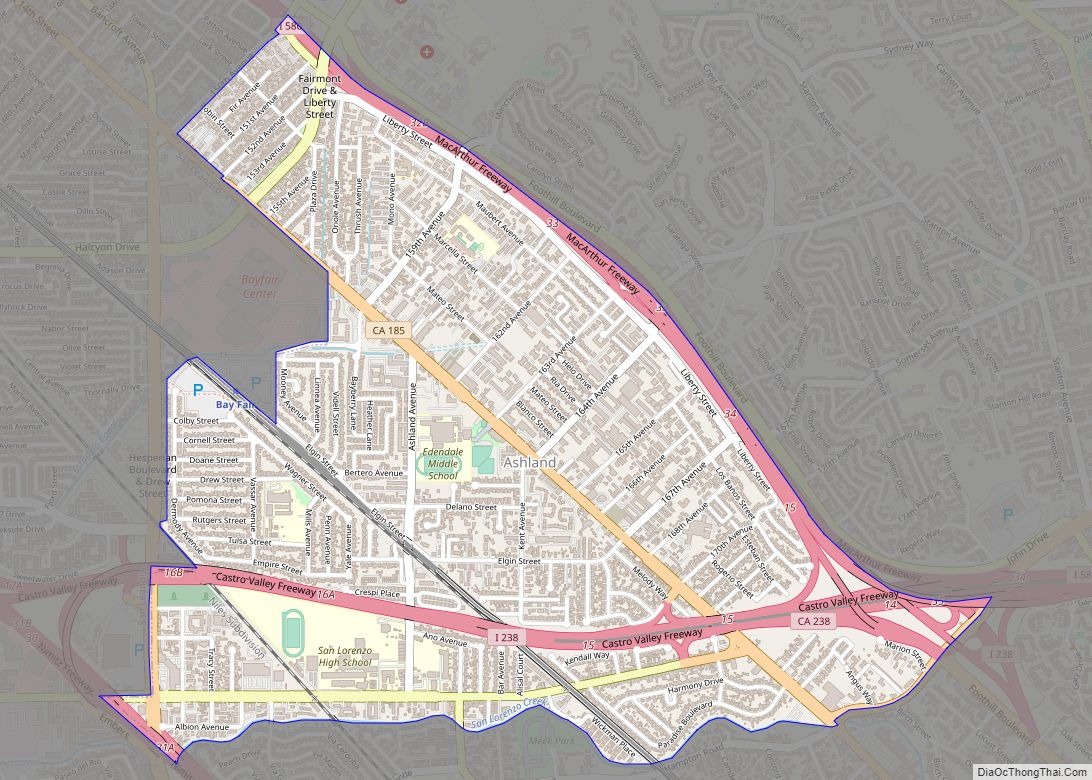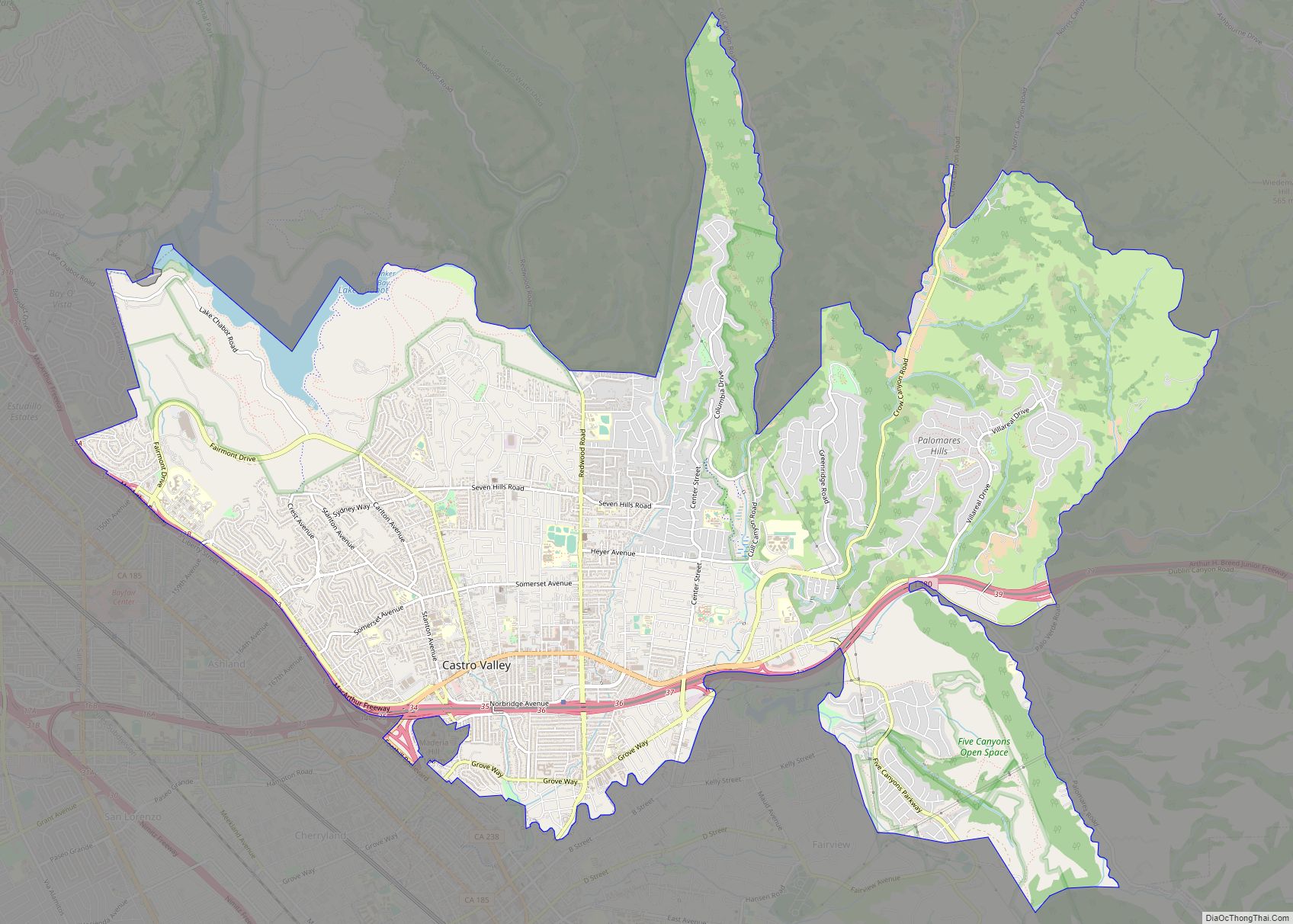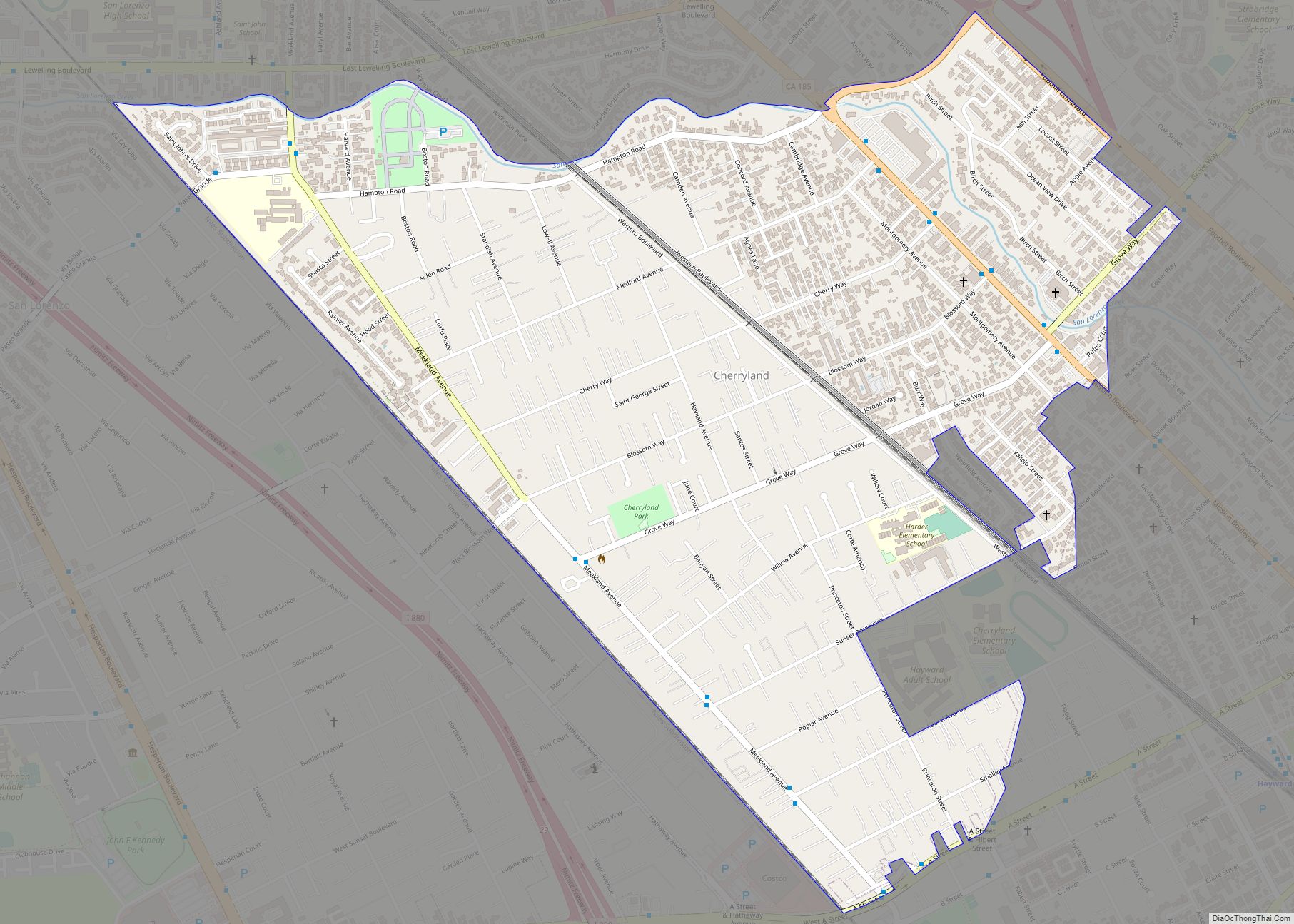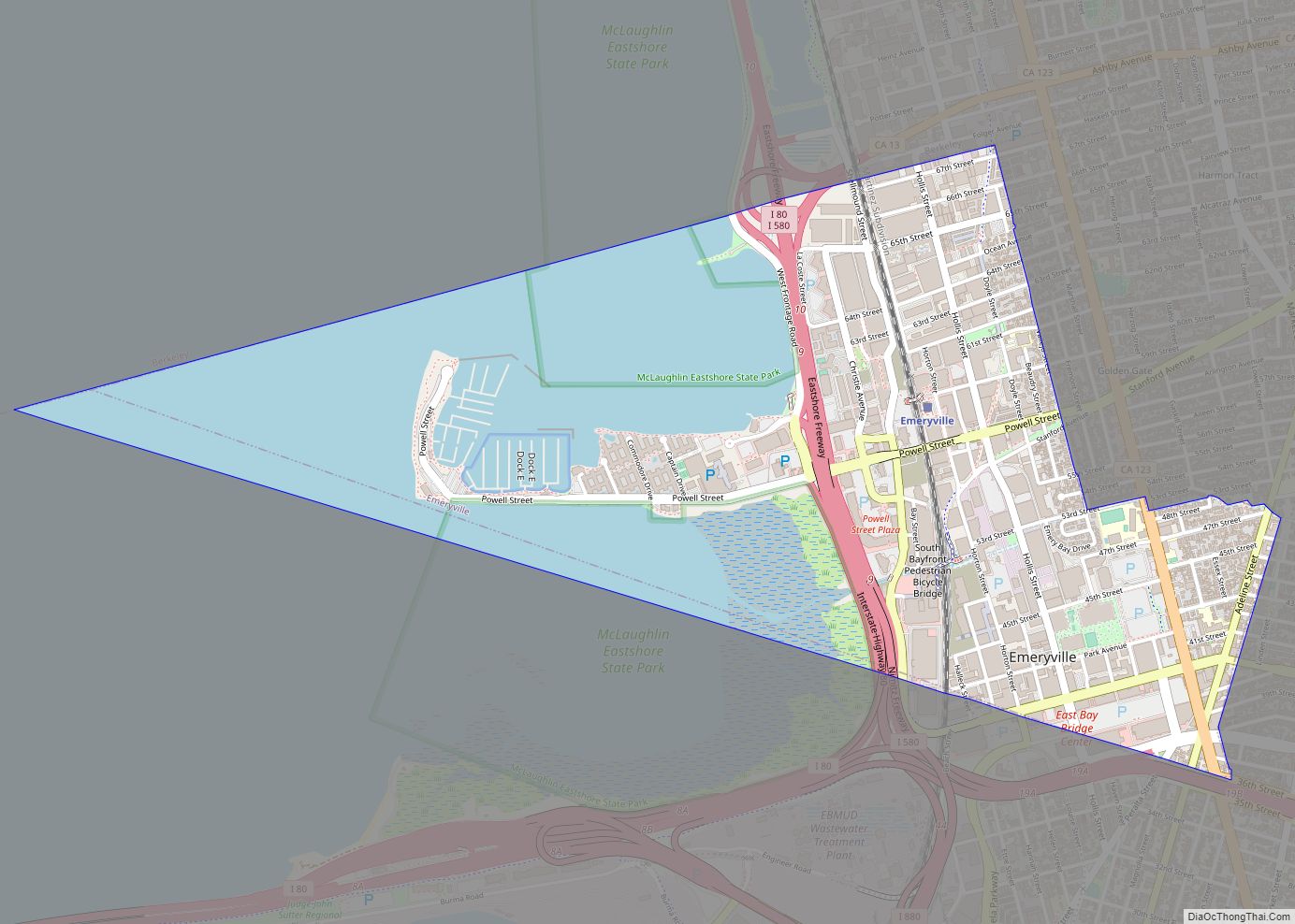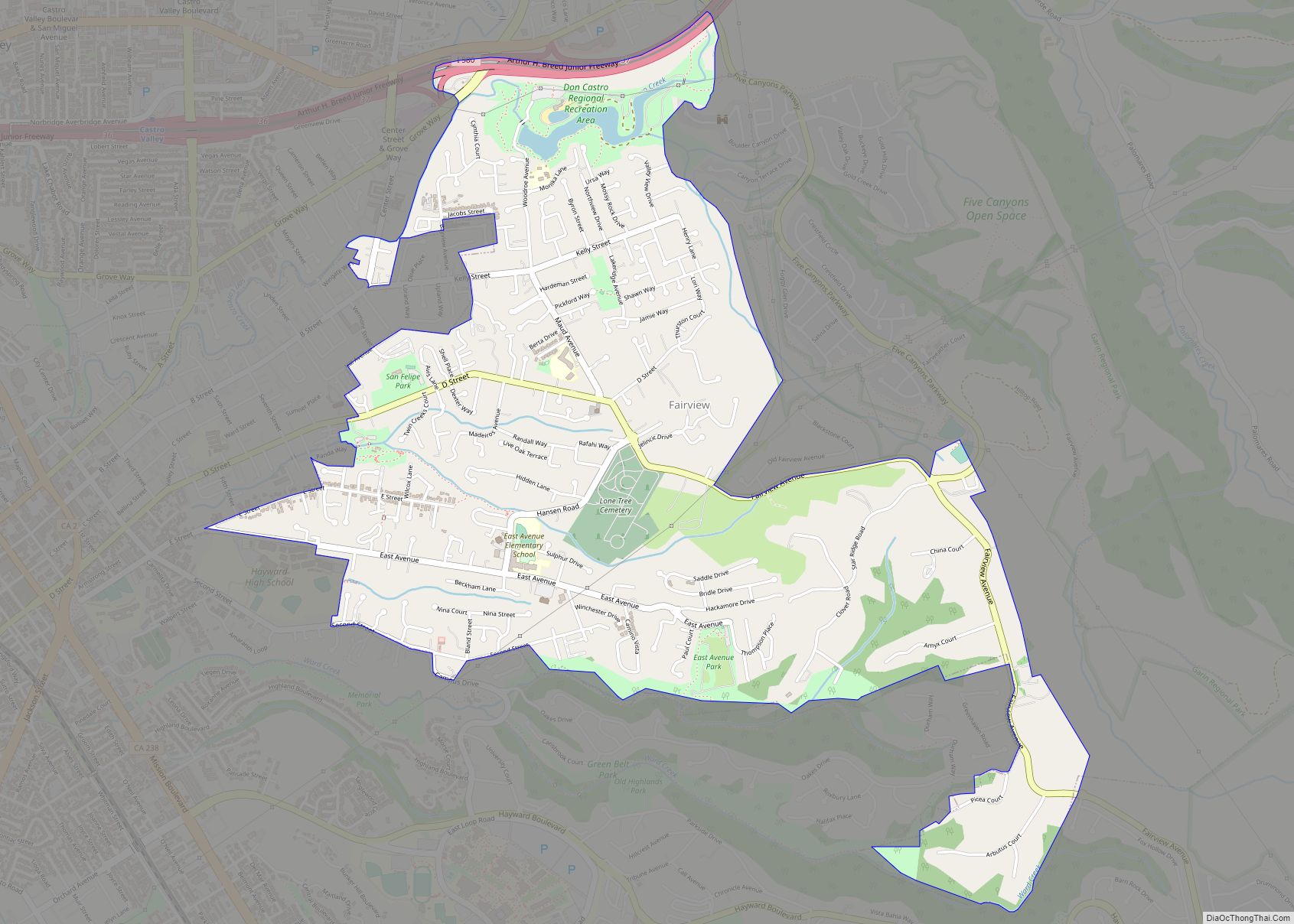Emeryville is a city located in northwest Alameda County, California, in the United States. It lies in a corridor between the cities of Berkeley and Oakland, with a border on the shore of San Francisco Bay. The resident population was 12,905 as of 2020. Its proximity to San Francisco, the Bay Bridge, the University of California, Berkeley, and Silicon Valley has been a catalyst for recent economic growth.
It is the home to Pixar Animation Studios, Peet’s Coffee & Tea, the Center for Investigative Reporting, Alternative Tentacles and Clif Bar. In addition, several well-known tech and software companies are located in Emeryville: LeapFrog, Sendmail, MobiTV, Novartis (formerly Chiron before April 2006), and BigFix (now HCL). Emeryville attracts many weekday commuters due to its position as a regional employment center.
Emeryville has some features of an edge city; however, it is located within the inner urban core of Oakland/the greater East Bay. It was industrialized before the First World War.
| Name: | Emeryville city |
|---|---|
| LSAD Code: | 25 |
| LSAD Description: | city (suffix) |
| State: | California |
| County: | Alameda County |
| Incorporated: | December 8, 1896 |
| Elevation: | 23 ft (7 m) |
| Total Area: | 2.25 sq mi (5.8 km²) |
| Land Area: | 1.28 sq mi (3.3 km²) |
| Water Area: | 0.97 sq mi (2.5 km²) 38.02% |
| Total Population: | 12,905 |
| Population Density: | 5,700/sq mi (2,200/km²) |
| ZIP code: | 94608 |
| Area code: | 510, 341 |
| FIPS code: | 0622594 |
| Website: | www.emeryville.org |
Online Interactive Map
Click on ![]() to view map in "full screen" mode.
to view map in "full screen" mode.
Emeryville location map. Where is Emeryville city?
History
Early history
Before the colonization of the area by Spain in 1776, this area was long the site of indigenous settlements. The historic Ohlone Native Americans encountered the Spaniards and later European colonists. They thrived on the rich resources of the bayside location: gathered clams from the mudflats, oysters from the rocky areas, caught fish, and hunted a variety of game. In addition, women gathered acorns from the local oak trees, roots, and fruit. The Ohlone discarded clam and oyster shells in a single place, over time creating a huge mound, now known as the Emeryville Shellmound.
During the Spanish and Mexican eras, colonists constructed a small wharf near the mouth of Temescal Creek adjacent to the shellmound. The wharf served the Peralta family’s Rancho San Antonio. It was used for loading cattle hides, the principal product of the ranch, onto lighters, and transferring them to ocean-going ships, including New England–bound schooners.
Cattle were a major part of the economy into the American era, when numerous meat packing plants were established along the bayshore in Emeryville between 67th and 63rd streets, in an area called “Butchertown”. The cattle processed here were raised in nearby ranches and farms, and brought in by rail or barge. The odors from the corrals and slaughterhouses were notorious and often mentioned in local newspapers of the 19th and early 20th century.
Emeryville’s first post office opened in 1884.
The Town of Emeryville was incorporated December 2, 1896. It was named after Joseph Stickney Emery, who came during the California Gold Rush and acquired large tracts of land in what became known as “Emery’s”. In 1884, Emery was president of a narrow-gauge railroad called the California and Nevada Railroad. The railroad was originally intended to extend from Oakland, through Emery’s (at the time, an unincorporated settlement along the bayshore) and east across the Sierra Nevada to the gold mining town of Bodie, California. From Bodie the railroad would extend east through Nevada to a connection with the Denver & Rio Grande Railroad. Despite these goals, the railroad was completed only from Oakland to Orinda. Its right-of-way was sold to the Santa Fe Railway. The Santa Fe constructed a rail yard and passenger depot below San Pablo between 41st Street and Yerba Buena Avenue. Although located in Emeryville, when the depot opened in 1902, it was called “Oakland” after the larger community.
20th century and beyond
The Key System, a local transit company, acquired the general offices of the California and Nevada and its nascent pier into San Francisco Bay. Key developed the pier to reach nearly to Yerba Buena Island. The Key System established its main rail yard adjacent to the yard of the Santa Fe in a large tract west of San Pablo Avenue. It was in the vicinity of Yerba Buena Avenue (so named because the island was visible in line with the thoroughfare). The Key System’s main power plant, used to drive its electric streetcars and commuter trains, was constructed adjacent to the city limits with Oakland. The immense smokestack was a local landmark for decades, surviving until being damaged in the Loma Prieta earthquake of 1989. It was demolished for safety reasons shortly thereafter.
The old Key System mainline to the pier, and later, to the Bay Bridge, ran in a subway below Beach Street and the Southern Pacific mainline near the power plant. That subway survives. Today it is used as a private entrance to the main sewage treatment plant of East Bay Municipal Utility District (EBMUD, the water utility serving Oakland and many surrounding cities).
In the late 1980s and early 1990s, after the Santa Fe spun off its real estate development arm, this company acquired the rail yards and shops of the Key System and Santa Fe. This real estate was redeveloped by what was called the Catellus Development Corporation, as a shopping center and multi-unit residential district.
In the late 19th century, the city developed a large park around the shellmound. This included two dance pavilions, one of which was built on top of the shellmound. The Oakland Trotting Park, for Standardbred horse racing, was built nearby at the junction of the Berkeley Branch line with the mainline of the Southern Pacific. The old Emeryville Arena was torn down in February 1920, to make way for a new idea for a new venue to revive the sport of dog racing, but using what the Oakland Tribune described as an “automatic rabbit”.
On May 29, 1920, the first greyhound racing track to employ a mechanical lure in place of a live rabbit opened in Emeryville.
In the early 20th century, Emeryville was as well known for its gambling houses and bordellos as it was for its booming industrial sector. Earl Warren, then Alameda County district attorney, later California governor and Chief Justice of the United States, described it as “the rottenest city on the Pacific Coast”. During Prohibition and the Great Depression, Emeryville was a site of numerous speakeasies, racetracks and brothels; it became known as a somewhat lawless red light center. Today’s popular local restaurant, The Townhouse, was operated as a speakeasy during Prohibition. The Oaks Room Card Club operates today as a legal gambling establishment on San Pablo Avenue.
Emeryville was the site of Oaks Park, the home turf of the Pacific Coast League’s Oakland Oaks. The ballpark was located on the block bounded by San Pablo, 45th Street and Park Street (the fourth side was Watts Street). The site is now partly empty and fenced off. It is overlapped by Pixar Studios. Pixar’s main gate (on Park Street) lies directly on the old segment of Watts Street. The stadium did not front directly on San Pablo, where a strip of various small commercial buildings stood. They were replaced by the current, one-story commercial building housing several chain businesses.
During World War II, Emeryville was the southern terminus of the Shipyard Railway, a specially constructed electric rail line operated by the Key System to transport defense workers to the Kaiser Shipyards in Richmond. The station was on the west side of San Pablo Avenue on the Key’s yard property. The tracks led to San Pablo Avenue, where they were merged into existing streetcar tracks.
From the late 19th into the early 20th century, Emeryville continued development as an industrial city. Joining the meat-packing plants were the Judson Iron Works and the Sherwin-Williams paint company. From 1939 until the 1970s, the Sherwin-Williams plant roof featured a massive animated neon sign showing a can of red paint tilting, spilling, and covering a globe of the earth — with the slogan “Cover the Earth”. It was a familiar sight to eastbound motorists on the Bay Bridge.
For decades the city was also the location of Shell Development, the research arm of Shell Oil Company; it relocated in 1972 to Houston, Texas. A large scrap metal yard (part of the Judson Steel mill) and its distinctive neon “Judson Steel” sign were visible for decades from the Eastshore Freeway until the mid-1980s. A large facility of the Pacific Intermountain Express (PIE) trucking firm was also visible. A heavy truck manufacturing division of what was formerly International Harvester, later Navistar, was located in Emeryville. One of its more popular over-the-road semi-truck models, the International DCO-405, became commonly and affectionately known as an “Emeryville”.
By the late 1960s, industries were beginning to move away from Emeryville. With the loss of jobs, the city declines. This began to change in the mid 1970s starting with the development of the marina section of Emeryville. The Judson steel mill abruptly shut down in the fall of 1986, after more than 100 years of operation, in the wake of declining profits and contentious labor negotiations.
By the late 1980s, a large shopping area had begun to develop north and south of the Powell Street corridor. Additionally, the Chiron Corporation (now Novartis), a major biotechnology company, established its headquarters just south of the old junction of the SP mainline tracks and the old Berkeley branchline (Shellmound Junction) at the end of Stanford Avenue, the site of the old Shellmound trotting course.
Following the Loma Prieta earthquake in 1989, a new Amtrak depot was built in Emeryville to replace the former 16th Street Station in West Oakland. It had been deteriorating even before it was seriously damaged by the quake. The Emeryville station serves Amtrak’s California Zephyr, Coast Starlight, San Joaquin, and Capitol Corridor trains. The California Zephyr originates here with service daily to Chicago, Illinois via Salt Lake City, Utah and Denver, Colorado. Buses link the station with San Francisco.
In the late 1980s the Emeryville Public Market opened; this farmers’ market also features up to twenty restaurants.
By the 1990s, the former tracts of the Santa Fe and Key System yards were redeveloped as a large shopping and residential area, as was the Shellmound corridor. Development of these areas included major roadwork, with the extension of 40th Street. The work included construction of a large overpass across the Southern Pacific (now Union Pacific) railroad tracks; it connected 40th Street to an extension of Shellmound Street, creating a single thoroughfare linking two sections of the new Emeryville. On the northern stretch of Shellmound Street, the Emery Marketplace and a movie multiplex were built. In 2007, the western end of Yerba Buena Avenue was linked with the northern end of the Mandela Parkway, creating a new through route between Emeryville and West Oakland.
In 2001, the city contracted developer Madison Marquette to build a new shopping center, the Bay Street Shopping Center. It was to be built on the site of a defunct paint factory. But this was a historic site of an Ohlone village and sacred burial ground. Madison Marquette developers worked with archaeologists and Ohlone tribe representatives in order to avoid disturbing the human remains. The tribe approved reinterment of some remains at an undisclosed location on the site. The completed mall displays photographs of the historic shellmound, but it does not mention the burial grounds. An Ohlone representative said they believed the information would make shoppers there uncomfortable.
Emeryville Road Map
Emeryville city Satellite Map
Geography
According to the United States Census Bureau, the city has a total area of 2.0 square miles (5.2 km), of which 1.2 square miles (3.1 km) of it is land and 0.8 square miles (2.1 km) of it (38.02%) is water. Named Watergate, the Emeryville marina is home to a mixed-use development, including two marinas (one public, the other private), a park, a residential condominium community known as Watergate, a business park with several office buildings, and several restaurants.
Mudflats and other environmental features
At one time, the Emeryville Mudflats were famous for their stench. In the 19th and early 20th century, this was caused by the effluent from the “Butchertown” area, where several meat-packing plants operated along the bayshore. They also dumped stripped carcasses in the bay here. Later, untreated sewage from Emeryville, Oakland, and Berkeley flowed directly into the bay over the mudflats, producing hydrogen sulfide gas, particularly noticeable on warm days. In the 1950s the East Bay Municipal Utility District constructed a regional sewage treatment plant near the eastern terminus of the San Francisco–Oakland Bay Bridge, which, for the most part, cured the noxious problem.
The Emeryville Mudflats became notable in the 1960s and 1970s for public art, erected (with neither permission nor compensation) from driftwood timbers and boards by professional and amateur artists and art students from local high schools, UC Berkeley, the California College of Arts and Crafts and the Free University of Berkeley. The mudflats were even featured in the 1971 film Harold and Maude. These unsanctioned works were admired by some drivers heading westbound on the San Francisco–Oakland Bay Bridge from Interstate 80.
In the late 1990s, the sculptures and materials were removed in the interest of establishing a more natural and undisturbed marshland for the nurturing of wildlife. This process continues around the bay in many other wetlands, former diked grazing fields, and salt production evaporation ponds.
Historically, Emeryville had been the location of a number of heavy industrial uses such as Judson Steel, whose properties were developed by bringing in waste and construction debris fill from San Francisco in the early 1900s. Correspondingly much of the underlying soil contained heavy metals, hydrocarbons and other soil contaminants. Much of this contamination was removed in the 1980s when the considerable wave of redevelopment occurred. The population had increased to almost 7,000 by the year 2000. Since then, the population has continued to grow and is estimated by General Plan projects a population of 16,600 by 2030. In addition, the city is home to about 20,000 current jobs; this number is projected to increase to about 30,000 by 2030.
See also
Map of California State and its subdivision:- Alameda
- Alpine
- Amador
- Butte
- Calaveras
- Colusa
- Contra Costa
- Del Norte
- El Dorado
- Fresno
- Glenn
- Humboldt
- Imperial
- Inyo
- Kern
- Kings
- Lake
- Lassen
- Los Angeles
- Madera
- Marin
- Mariposa
- Mendocino
- Merced
- Modoc
- Mono
- Monterey
- Napa
- Nevada
- Orange
- Placer
- Plumas
- Riverside
- Sacramento
- San Benito
- San Bernardino
- San Diego
- San Francisco
- San Joaquin
- San Luis Obispo
- San Mateo
- Santa Barbara
- Santa Clara
- Santa Cruz
- Shasta
- Sierra
- Siskiyou
- Solano
- Sonoma
- Stanislaus
- Sutter
- Tehama
- Trinity
- Tulare
- Tuolumne
- Ventura
- Yolo
- Yuba
- Alabama
- Alaska
- Arizona
- Arkansas
- California
- Colorado
- Connecticut
- Delaware
- District of Columbia
- Florida
- Georgia
- Hawaii
- Idaho
- Illinois
- Indiana
- Iowa
- Kansas
- Kentucky
- Louisiana
- Maine
- Maryland
- Massachusetts
- Michigan
- Minnesota
- Mississippi
- Missouri
- Montana
- Nebraska
- Nevada
- New Hampshire
- New Jersey
- New Mexico
- New York
- North Carolina
- North Dakota
- Ohio
- Oklahoma
- Oregon
- Pennsylvania
- Rhode Island
- South Carolina
- South Dakota
- Tennessee
- Texas
- Utah
- Vermont
- Virginia
- Washington
- West Virginia
- Wisconsin
- Wyoming
